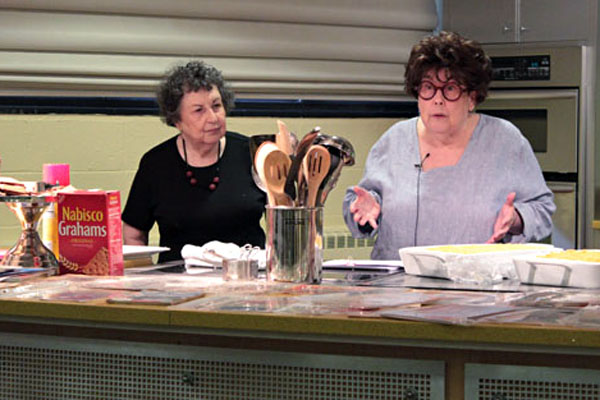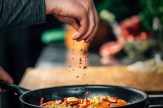The evolution of food

The way Marilynn and Sheila Brass make macaroni and cheese could be considered a lost art.
Instead of preparing the dish using today’s factory produced all-in-one kits, the Brass sisters combine more than 15 ingredients, including cheddar, ricotta, provolone, and parmesan, to make what they call the “Billionaire’s Macaroni and Cheese.”
“We learned the recipe from a friend 35 years ago,” explained Marilynn, 72. “It was called ‘Millionaire’s Macaroni and Cheese’ and when we decided to include it in our cookbook I said to Sheila, ‘With inflation we should probably change it to Billionaire’s.’”
The Brass sisters, who have written two cookbooks and hosted their own cooking show on WGBH TV, showed off their culinary skills earlier this month at Northeastern’s Xhibition Kitchen.
The audience—and eager taste-testers—comprised of students in a new course launched this summer called Food, Food Policy, and Health. It is the brainchild of John Auerbach, director of the Institute on Urban Health Research and Practice, and his husband Corby Kummer, restaurant critic for Boston Magazine and senior editor of The Atlantic.
Starting with the eating habits of the Pilgrims, the course looks at the history of food in the U.S. and how policies and public opinions have influence how people eat, from the development of food standards in the late 1800s to the obesity epidemic.
“It’s ambitious,” Auerbach said of the course. “There has been increased attention on the importance of food policy and consumption, and this course will delve into the history of that.”
For Rip Weaver, MPH’14, this is the final course before starting a capstone project in the fall. He said he has always enjoyed learning about food culture and this course helped to solidify his passion for healthy eating in America. After graduating Weaver said he hopes to stay in Boston and work on issues related to healthy food access and eating for underserved populations.
“I wanted to expand my knowledge of public health policy, particularly as it relates to food and agriculture,” Weaver explained. “I was drawn to the fact that the course combines various teaching methods, including traditional approaches such as guest lectures, readings, and student projects, with more hands-on experiences like site visits and cooking demonstrations.”
The Brass sisters’ cooking demo served as an opportunity for students to taste different versions of macaroni and cheese and learn how the dish has changed since the late 1930s, when Kraft Foods introduced the mac and cheese dinner. The students, many of whom said they grew up eating homemade macaroni and cheese, had high praise for the Brass sisters’ dish describing it as “rich in flavor.”
In addition to the Brass sisters, other Xhibition Kitchen guests of the food policy course will include Maureen Timmons, director of Northeastern Dining Services, and Deb Fantasia, Xhibition Kitchen coordinator, who will discuss what it’s like to cook for 20,000 people every day.
As part of the course, students will also tour the Boston-based Legal Sea Food’s Quality Control Center to learn how the company measures the quality of its food and makes sure its safe to eat. The students will also visit the Haley House Bakery Café in Roxbury, which uses food as a vehicle to help people and bring communities together.
“We wanted to design a course that we would want to take ourselves,” Kummer said. “The kitchen is so unique to the school. We have cooks and teachers coming in who are very concerned about food access and the food system.”





